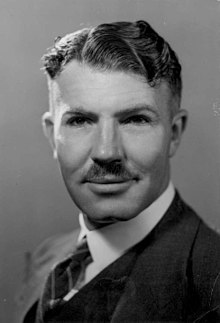Gordon Freeth
Sir Gordon Freeth, KBE (* 6. August 1914 in Angaston, South Australia; † 27. November 2001[1] in Perth) war ein australischer Politiker und unter anderem Außenminister des Landes.
Leben
Freeth wurde in Angaston, South Australia geboren und besuchte die Sydney Church of England Grammar School, so wie die Guildford Grammar School in Western Australia. Er machte seinen Bachelor of Laws im Jahr 1938 an der University Western Australia. Im Rudern gewann er bei den British Empire Games 1938 in Sydney im Vierer eine Gold-Medaille. Im Jahr 1939 heiratete er Joan Baker, mit der er Zwillingstöchter zusammen hatte – Felicity und Susan – sowie einen Sohn Robert. Noch im selben Jahr begann er in Katanning, Western Australia, als Anwalt zu arbeiten. Nach Beginn des Zweiten Weltkriegs zog es ihn in die Royal Australian Air Force und er flog Bomber während des Neuguinea-Feldzuges. 1945 erreichte er den Dienstrang eines Flight Lieutenant.[2]
Politische Karriere
Freeth wurde als Mitglied der Liberal Party of Australia im Wahlbezirk Forrest in Western Australia bei den Bundeswahlen 1949 als Abgeordneter ins Repräsentantenhaus gewählt. Er wurde als Innenminister bestimmt, so wie als Arbeitsminister. In den Jahren 1958 und 1963 wurde er zum Verkehrsminister ernannt. Im Februar 1968 wurde er Luftfahrt-Minister und übernahm den Posten von Peter Howson. Im Februar 1969 wurde er Außenminister als Nachfolger von Paul Hasluck, welcher von nun an Generalgouverneur Australiens war. Bei den Bundeswahlen 1969 unterlag er dem Kandidaten der Australian Labor Party, Frank Kirwan, und schied aus dem Repräsentantenhaus aus.[2]
Von 1970 bis 1973 war Gordon Freeth Botschafter in Japan und Hochkommissar im Vereinigten Königreich von 1977 bis 1980.
Ehrungen
Im Jahr 1978 wurde Freeth als Knight Commander des Order of the British Empire geadelt.[2] Zudem ist die Freeth Bay in der Antarktis nach ihm benannt.
Einzelnachweise
- ↑ John Farquharson: Freeth, Sir Gordon (1914–2001). In: oa.anu.edu.au. Obituaries Australia, National Centre of Biography, Australian National University, abgerufen am 25. Oktober 2016 (englisch).
- ↑ a b c John Howard: Condolences: Adermann, Hon. Albert Evan, AO, Freeth, Hon. Sir Gordon, KBE, Chaney, Hon. Sir Frederick Charles, KBE, AFC. Hansard. Parliament of Australia, 12. Februar 2002. Abgerufen am 4. Oktober 2007
| Personendaten | |
|---|---|
| NAME | Freeth, Gordon |
| KURZBESCHREIBUNG | australischer Politiker und Außenminister |
| GEBURTSDATUM | 6. August 1914 |
| GEBURTSORT | Angaston, South Australia |
| STERBEDATUM | 27. November 2001 |
| STERBEORT | Perth |
Auf dieser Seite verwendete Medien
Commonwealth Coat of Arms of Australia granted by Royal Warrant signed by King George V on 19 September 1912.
IMPORTANT:This image is an artist's interpretation of the original (1912) official version of the Commonwealth Coat of Arms shown in Commons on the Australian coat of arms page. A variant of the original, with a transparent background, is shown on this page.
| “ | Quarterly of six, the first quarter Argent a Cross Gules charged with a Lion passant guardant between on each limb a Mullet of eight points Or; the second Azure five Mullets, one of eight, two of seven, one of six and one of five points of the first (representing the Constellation of the Southern Cross) ensigned with an Imperial Crown proper; the third of the first a Maltese Cross of the fourth, surmounted by a like Imperial Crown; the fourth of the third, on a Perch wreathed Vert and Gules an Australian Piping Shrike displayed also proper; the fifth also Or a Swan naiant to the sinister Sable; the last of the first, a Lion passant of the second, the whole within a Bordure Ermine; for the Crest on a Wreath Or and Azure A Seven-pointed Star Or, and for Supporters dexter a Kangaroo, sinister an Emu, both proper. | ” |



